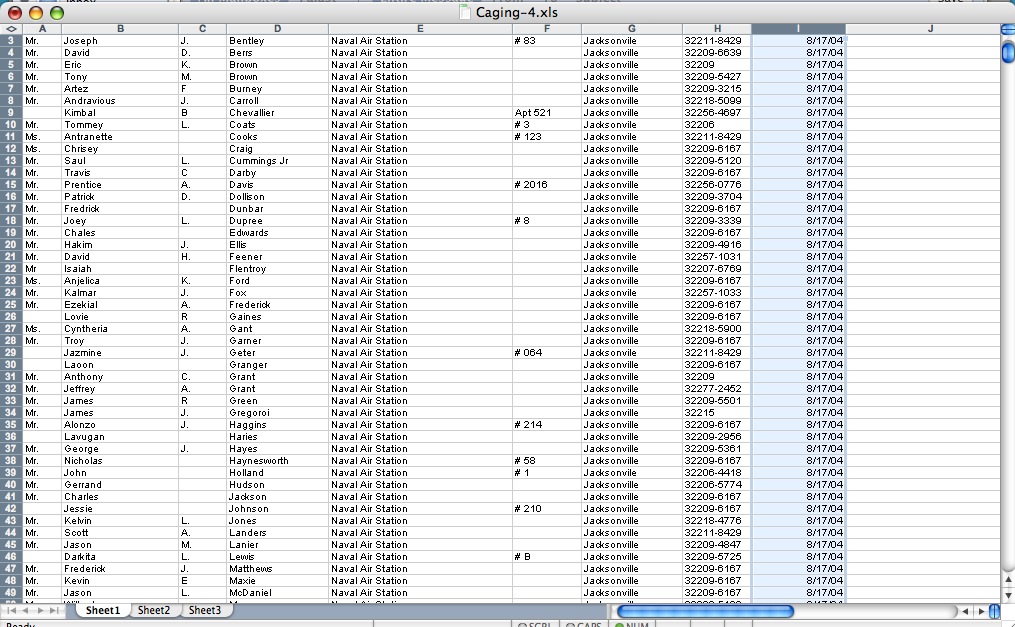Zogby – Voters Question Outcome Of ’04 Election
Posted in Exit Polls, General on September 26th, 2006 ZOGBY POLL:
VOTERS QUESTION OUTCOME OF 2004 PRESIDENTIAL ELECTION
Only 45% of Voters “Very Confident†Bush Won Election “fair and squareâ€
By Michael Collins
Part II of a II Part Series (Part I)
“Scoop†Independent News
Washington, DC
At their lowest points of popularity, do you recall anyone who claimed that Presidents’ Carter and Nixon stole their elections or that they didn’t win fair and square? Did any analysts or activist groups clam massive election fraud in the elections that brought these ultimately very unpopular presidents to office?
How confident are you that George Bush really won the 2004 presidential election? If you are a typical American voter and you have doubts, how did those doubts arise? A mid August Zogby Poll of 1018 likely voters answered the first of these two very important questions (The author was a contributing sponsor for the survey.)
How confident are you that George W. Bush really won the 2004 presidential election?
Very confident that Bush won fair and square…….. 45.2%
Somewhat confident that Bush won fair and square… 20.0%
Not at all confident that he won fair and square…… 32.4%
Other/not sure………………………………………. 2.4%
This is a remarkable result. Nearly two years into the second term of his presidency, less than half of those polled think that the 2004 election victory was “fair and square.†20% say they are “somewhat†confident, which is hardly an endorsement of legitimacy. Webster’s defines “somewhat†as follows: “…in some degree or measure: SLIGHTLY.“ This does not exactly qualify as an endorsement of a critical democratic process. The 32% who are “not at all confident†represent a major portion of the population holding the belief that Bush failed to win without cheating. Combining “not at all confident†with “somewhat†“slightlyâ€, according to Webster’s, produces a category of 52% who “doubt†the legitimacy of the election. Altogether, these results are a clear vote of no confidence.

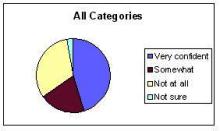
Combining “not confident at all†and “somewhat†(“in some degree measure: SLIGHTLYâ€) produces a category of “Doubts.†This gives a clear picture on legitimacy versus illegitimacy issue.
Survey Excel file available here.
Those who doubt: Not at all confident that he won fair and square – 32%
Fifty nine percent of Democrats, 5% of Republicans, and 34% of independents comprise the group with no confidence in a Bush win. Dividing the group by race shows that 54% of Asians and 71% percent of African Americans have serious doubts in the legitimacy of the election, along with 25% of whites and 37% of Latinos. Thus, a majority of Asian and African American voters lack confidence in the president’s legitimacy to rule while significant numbers of whites and Latinos do as well.
Groups thought to be in the hip pocket of the Republican administration show no confidence at a significant rate. NASCAR fans doubt the election results at a rate of 28% and born again Christians at 25%. Those in rural areas and the suburbs show some real doubt with rates of 28% and 29% respectively demonstrating a significant level of doubt. Members of the armed forces were right at the survey average with 32% questioning the legitimacy of the election.
The geographical distribution of no confidence was mildly surprising: East, 44%; South 30%; Central States/Great Lakes 24%; and West35%. Given the strength of the Republican Party in the South and relative strength of Democrats in the Central States/Great Lakes, this outcome stands out.
Those who without doubt: Very confident that Bush won fair and square – 45%
Fifteen percent of Democrats, 80% of Republicans, and 39% of independents comprise the group that is very confident that Bush won fair and square. Dividing that group by race shows that 39% of Asians and 9% percent of African Americans are very confident in the legitimacy of the election, along with 51% of whites and 38% of Latinos. Central States/Great Lakes comprise 54% of this group with the South at 46%. The West comprises 42% with the East accounting for just 32% of likely voters.
Whites, 51%, born again Christians, 58%, and people with household incomes over $100,000 are at the top of those very confident in a legitimate election. Only 54% of the rural population was very confident in a legitimate election. This may reflect the significant decrease in rural support for Bush in 2004 when compared to the 2000 election. All of these figures in the low fifties indicate that even among core constituencies, there are barely a majority of voters with a high degree of confidence that the election was legitimate.
Those in between: Somewhat confident that Bush won fair and square – 20%
Democrats and Independents, at 24% and 22% respectively, out number Republicans at 14%. Those who said that they were “somewhat confident†in the legitimacy of the election were evenly distributed around the country with only 3% separating the lowest reporting region, the South at 19%, and the West at 21%, which was the highest. Born again Christians come in at 15% percent, while non sectarians report at a rate of 19%.
The “in betweens†show less difference than the “very confident†and the “not confident at all†responders among the various subgroups polled.
Where they live: confidence by location
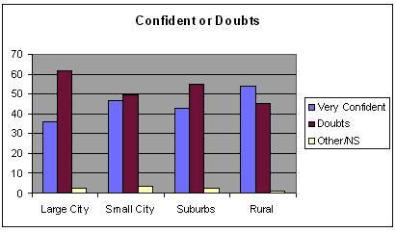
Those with “doubts are more likely to live in a large city. But nearly half in rural areas show “doubts.â€
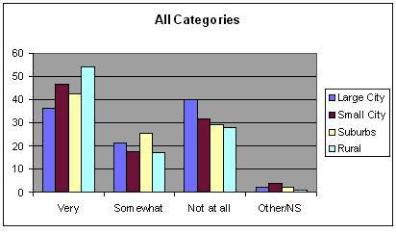
The Importance of this Survey
Why are these results important? The notion of legitimacy is central to political systems and central to the ability of an elected leader to rule effectively (although a low level of legitimacy can allow a ruler to stay in power for a period). The vast majority of the public, regardless of political leanings, needs to confer legitimacy through a belief that those elected were elected fair and square. Significant numbers doubting basic legitimacy create major problems for those “elected†and for stability in the system. The result of only 45% trusting the system arises in a news environment in which the main stream media simply refuses to doubt the fairness or the 2004 election and studiously avoids any charges of outright election fraud and a corrupted result.
How the doubts arose will require more research. The response to other Zogby Poll questions in the same survey provides a major hint. 60% of American voters believe that tampering with only one machine can alter the outcome of an entire election. Nearly 80% oppose the use of secret, vendor-only computer code to run voting machines. Plus an amazing 92% of respondents said that they want the right to watch votes being counted and the right to make inquires of election officials regarding vote counting. They want that right because it belongs to them but also, I argue, because they doubt the process and the checks and balances. These doubts about the election occur at the same time there is doubt about the outcome and interact to reinforce each other.
Grave doubts exist about the 2004 presidential election in Ohio and elsewhere. Questions are asked primarily by mathematicians who cannot tolerate a seeming suspension of the laws of mathematics for one day only, November 2, 2004, voting rights activists who witnessed voter suppression and election irregularities at an extraordinary rate, and ordinary citizens whose civic concern was awakened by the 2000 Supreme Court selection and the 2004 election that defied all logic.
Despite the productivity of election fraud researchers and voting rights advocates, very little attention has been given to questions of election fraud by the corporate media. The significant vote of no confidence expressed by a representative sample of 1018 likely voters was driven by several factors: from information gained through channels other than corporate media outlets or due to a general distrust of the President based on his behavior and actions or a combination of these and other influences.
What does this mean? Some preliminary thoughts.
This survey elaborates another Zogby Poll conducted in Pennsylvania and sponsored by OpEdNews.com. In that survey, 39% of Pennsylvania residents indicated that they thought that 2004 Presidential election was stolen. In the current survey, a middle category was created to capture those with doubts, only “somewhat confident†that Bush won fair and square. By creating that category in this national poll of likely voters, those who doubt legitimacy increased 13 percentage points to 52% while those likely to share the sentiment that 2004 was stolen, dropped from the Pennsylvania 39% to the national sample of 32%.
At this point, the Bush Presidency is an illegitimate one, lacking in the necessary consensus to rule with any degree of confidence by the people. We have entered the Potemkin Village of democracy where the façade of legitimacy is nothing more than a Hollywood back lot. This is the inescapable conclusion from this poll of likely voters.
Combining “not at all’ and “somewhat†responders, over half of American voters have doubts about the election, with a third of the total survey expressing serious doubts about the outcome of the election. Despite what the script writers at ABC and the other networks weave into the nightly network indoctrination, there is a vast distrust of this president and this administration; a distrust so profound that it includes a belief that the president wasn’t even re-elected in 2004.
Corporate Media: Asleep at the Switch
There won’t be much discussion of this Zogby poll by corporate media reporters and pundits. If it occurs, it might go something like this: “Most Americans confident in 2004 Election;†“Bush Still Solid with the People;†“Core Groups Support Outcome of 2004 Election.†Of course, none of those headlines will appear. For one or a multitude of reasons, the American corporate media has studiously ignored any controversy concerning election 2004. To discuss questions of legitimacy in public would entail raising the question of a stolen election. It won’t happen but it should. .
If we assume that this data is actually discussed by the corporate media, a dismissal strategy is available. The headlines would read: “Doubt in Legitimacy of 2004 Presidential Election Based on Attitude toward Bush Performance†or, for certain news organizations, “Complainers Doubt 2004 Outcome.†Those who think the country is headed in the right direction comprise 79% of those who are very confident in 2004 results. They comprise only 8% of the “not confident at all†group. Those who think the country is headed in the wrong direction represent 26% of the very confident responders and 47% of the not confident at all group.
Of course, President Carter’s popularity dropped below 30%, a majority of Americans were positive we were headed in the wrong direction. You will be very hard pressed to find one single voice rose to challenge Carter’s popular vote victory, even though his victory margin was narrow. The hypothesized right-wrong explanation of this exceptionally low level of confidence in the system is not a particularly good argument but it will not be needed.
There is a uniform failure to address the legitimacy of the 2004 election. It is not the fault of the public. From these results, it is easy to imagine a robust dialogue followed closely by an intense public debate on the real questions that lead those who do to doubt the legitimacy of the 2004 presidential election. With such a debate, the numbers “not at all confident†would rise even higher. What a shame it would be if the information managers win yet again.
Copyright. Permission to reproduce in whole or part with attribution to the author, Michael Collins, a link to “Scoop,†and attribution of polling results to Zogby International.
Michael Collins is a writer who focuses on clean elections and voting rights. He is the publisher of the web site, www.ElectionFraudNews.com. His articles in “Scoop†Independent News can be found here.
MichaelCollins @ electionfraudnews.com
***APPENDIX*** The Zogby poll was conducted from August 11 through 15, 2006. 1018 adult voters were interviewed by phone. The sample of people interviewed reflects the demographic and regional diversity of the United States. Due to the size, it has a 3.1 % (+/-) margin of error. 95% of Zogby’s political polls have come within a 1% margin of accuracy in predicting election outcome. The survey was commissioned and sponsored by election rights and business law attorney Paul Lehto of Everett, Washington. This author, Michael Collins, was a contributing sponsor, along with Democracy for New Hampshire.
END


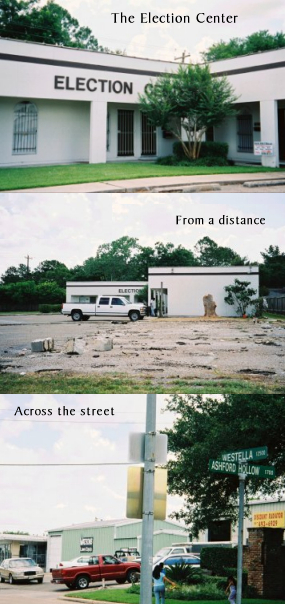

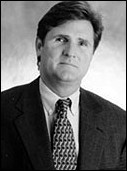 An Exclusive Interview for
An Exclusive Interview for  Recently, Robert F. Kennedy Jr., (
Recently, Robert F. Kennedy Jr., (
 Direct Recording Electronic (DRE) Voting Machines with VVPB: A voter’s choice is captured both internally, in electronic form, and printed on a paper ballot. The ballot can be checked by the voter before being submitted. The paper ballots would count as the actual votes, taking precedence over any electronic counts and would be available for audits and recounts. (Warning: About 1/3 of voters do not check the printed ballots, assuming that they must be accurate. Not true!)
Direct Recording Electronic (DRE) Voting Machines with VVPB: A voter’s choice is captured both internally, in electronic form, and printed on a paper ballot. The ballot can be checked by the voter before being submitted. The paper ballots would count as the actual votes, taking precedence over any electronic counts and would be available for audits and recounts. (Warning: About 1/3 of voters do not check the printed ballots, assuming that they must be accurate. Not true!)